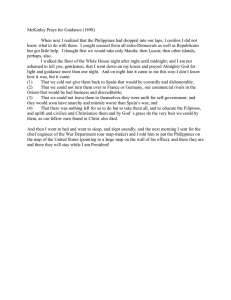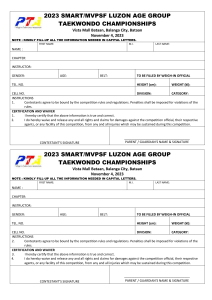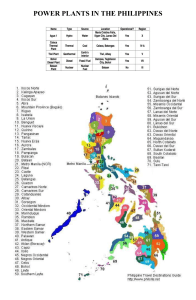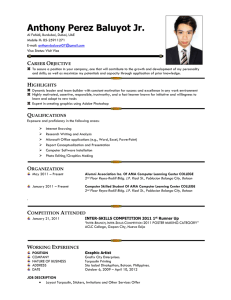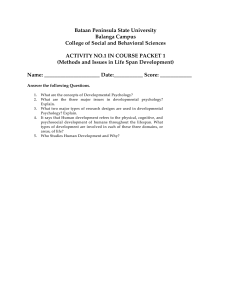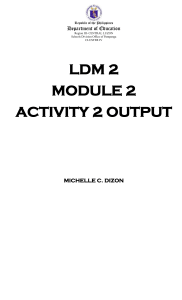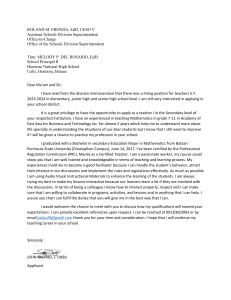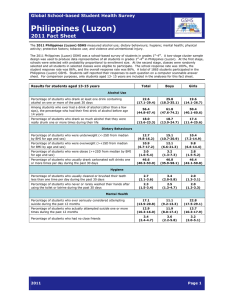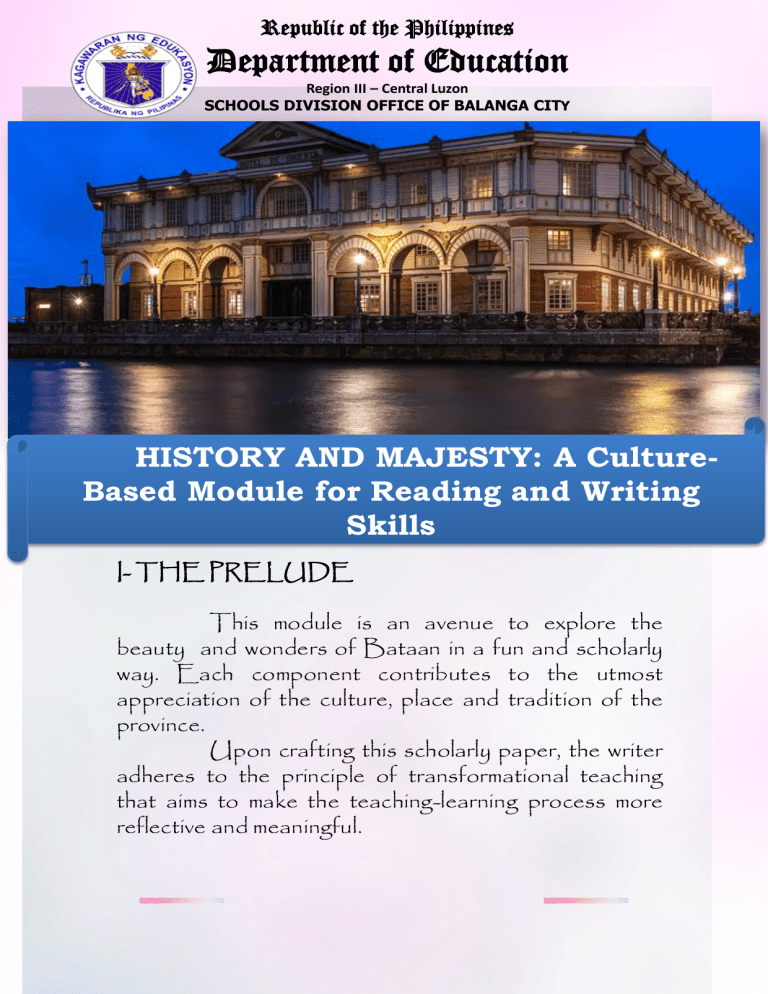
Republic of the Philippines Department of Education Region III – Central Luzon SCHOOLS DIVISION OFFICE OF BALANGA CITY HISTORY AND MAJESTY: A CultureHISTORY AND MAJESTY Based Module for Reading and Writing Skills I- THE PRELUDE This module is an avenue to explore the beauty and wonders of Bataan in a fun and scholarly way. Each component contributes to the utmost appreciation of the culture, place and tradition of the province. Upon crafting this scholarly paper, the writer adheres to the principle of transformational teaching that aims to make the teaching-learning process more reflective and meaningful. Republic of the Philippines Department of Education Region III – Central Luzon SCHOOLS DIVISION OFFICE OF BALANGA CITY HISTORY AND MAJESTY: A CultureHISTORY AND MAJESTY Based Module for Reading and Writing Skills II- ABOUT THE WRITER Mrs. Catherine Ambrocio-Baldoza is a pedagogue who is currently rendering her service at Bataan National high SchoolSenior High School. She teaches English subjects like English for Academic and Professional Purposes and Reading and Writing Skills. With her undying zeal to attain professional development, she was able to finish her master’s degree at Bataan Peninsula State University under the program Master of Arts in Education, major in Language Education. Republic of the Philippines Department of Education Region III – Central Luzon SCHOOLS DIVISION OFFICE OF BALANGA CITY HISTORY AND MAJESTY: A CultureBased Module for Reading and Writing Skills III- THE TEACHING-LEARNING PROCESS A. SUBJECT MATTER Identifying patterns of development TOPIC: CONTENT STANDARDS: The learner realizes that information in a written text may be selected and organized to achieve a particular purpose. PERFORMANCE STANDARDS: The learner critiques a chosen sample of each pattern of development focusing on information selection, organization and development. B. MELC AND UNPACKED OBJECTIVES Learning Competency: Compare and contrast patterns of written texts across disciplines (Narration and Description) Learning Objectives: At the end of the session, the students should be able to: 1. Craft a comprehensive account of their experiences through a pattern of development DESCRIPTION. 2. Narrate events chronologically by using signaling words and other transitional words and expressions. Republic of the Philippines Department of Education Region III – Central Luzon SCHOOLS DIVISION OFFICE OF BALANGA CITY HISTORY AND MAJESTY: A CultureBased Module for Reading and Writing Skills HISTORY AND MAJESTY III- THE TEACHING-LEARNING PROCESS C. PRELIMINARIES: A Threshold to Appreciation ACTIVITY 1: Tatak Bataeño, Kahit Saan Mang Dako Answer this question: “Could you tell me you’re a Bataeño without actually saying you’re a Bataeno?” “You can make mention of famous delicacies, expressions, places and traditions in Bataan. “ (Students’ varied answers will serve as SPRINGBOARD for A MORE thorough discussions.) Republic of the Philippines Department of Education Region III – Central Luzon SCHOOLS DIVISION OFFICE OF BALANGA CITY HISTORY AND MAJESTY: A CultureBased Module for Reading and Writing Skills III- THE TEACHING-LEARNING PROCESS C. PRELIMINARIES: A Threshold to Realization and Appreciation ACTIVITY 2: Depict. Divulge. Describe. Detour. DIRECTION: Locate the following tourist spots by naming the pictures and identifying the towns in Bataan where these places can be found. Then, NARRATE your experiences upon visiting those sites. (After discussing and processing their answers, the students may still mention/describe places in Bataan that they have visited which are not included in the activity.) Electronic source: https://guidetothephilippines.ph/articles/what-to-experience/bataan-tourist-spots Republic of the Philippines Department of Education Region III – Central Luzon SCHOOLS DIVISION OFFICE OF BALANGA CITY HISTORY AND MAJESTY: A CultureBased Module for Reading and Writing Skills III- THE TEACHING-LEARNING PROCESS D. PRESENTATION AND DISCUSSION: Unraveling of the Subject Matter Questions to ponder: 1. How did you describe and narrate your experiences in visiting different places in Bataan? How about your characteristics as Bataeño? 2. What are the words that you used to describe and narrate your accounts? 3. Did you find those words in doing the activities? TOPIC: PATTERNS OF DEVELOPMENT Writers don’t let their thoughts wander aimlessly. They think logically. They organize details in patterns. In the written language these patterns help you follow ideas more easily and, therefore, improve your understanding of the text. Authors use transition words and phrases to create patterns within their writing. The patterns of development that you utilized are DESCRIPTION and NARRATION. We used different adjectives in describing things or events while in narration, we utilized signaling words or time expressions. Republic of the Philippines Department of Education Region III – Central Luzon SCHOOLS DIVISION OFFICE OF BALANGA CITY HISTORY AND MAJESTY: A CultureBased Module for Reading and Writing Skills III- THE TEACHING-LEARNING PROCESS D. PRESENTATION AND DISCUSSION: Unraveling of the Subject Matter DESCRIPTION Vividly describing things is indeed a challenging task. In order to successfully characterize things, you must have a repertoire of descriptive words to properly give attribute to your topic. There following are the types of description which you can consider in giving attributes to a certain topic. 1. Subjective Description: Writers use descriptive paragraphs most often in fiction. Just think of lines like "It was a dark and stormy night," or "The mountains loomed above them." Description of time and place draws readers into other worlds and sets the stage where a story can unfold. Description of characters, their appearance, mannerisms, and utterances, helps us imagine what people are like. 2.Objective Description: Description is also used in reportorial and scientific writing, or other writing in which the goal is to present an objective picture of an object or scene. In these writing situations, the writer attempts to stay away from emotional impressions or responses, and instead report what is seen Republic of the Philippines Department of Education Region III – Central Luzon SCHOOLS DIVISION OFFICE OF BALANGA CITY HISTORY AND MAJESTY: A CultureBased Module for Reading and Writing Skills III- THE TEACHING-LEARNING PROCESS D. PRESENTATION AND DISCUSSION: Unraveling of the Subject Matter The following are the descriptive words that you may use in giving attributes to places, people and events. NOUNS ADJECTIVES places astonishing, breath-taking, majestic, astounding people resilient, hospitable events memorable, remarkable, significant, momentous Republic of the Philippines Department of Education Region III – Central Luzon SCHOOLS DIVISION OFFICE OF BALANGA CITY HISTORY AND MAJESTY: A CultureBased Module for Reading and Writing Skills III- THE TEACHING-LEARNING PROCESS D. PRESENTATION AND DISCUSSION: Unraveling of the Subject Matter NARRATION A narrative is a story. As a method of development, storytelling can be very effective for the simple reason that people love to hear stories, and will tune in to a story when their eyes glaze over at other styles of writing. Even when your purpose is to write an essay that is primarily to inform, analyze or argue, a narrative paragraph can be effective at drawing the reader in and establishing your voice in the essay. The following are the expressions that you can use in using the abovementioned pattern of development: -meanwhile, eventually, soon, first, second, then, amidst, consequently, finally, furthermore Republic of the Philippines Department of Education Region III – Central Luzon SCHOOLS DIVISION OFFICE OF BALANGA CITY HISTORY AND MAJESTY: A CultureBased Module for Reading and Writing Skills III- THE TEACHING-LEARNING PROCESS E. ENRICHMENT ACTIVITIES ACTIVITY 3: FUN IN HISTORY DID YOU KNOW THAT? There is a particular folklore that narrates the origin of the name of the province Bataan. According to it, Spanish Dominican Friars happened to see children playing with a big, ugly frog which they called ‘Batan’. They asked the adults about the children’s activity so the latter said ang mga ‘bata’ naglalaro si ‘Batan’. Due to language barrier, the friars came up with the term “Bataan” and eventually became the name of the province. There are still other folklores which trace the origin of the name ‘Bataan”. However, despite having numerous versions of the story, the identity of being a ‘Bataeño’ will always remain constant and remarkable: Bataan, Bayani at Banal. DIRECTIONS: Upon pondering on the abovementioned folklore, re-tell the story of the origin of a town’s name in Bataan. You can find and read the stories on the succeeding parts of this module. SUGGESTED ACTIVITIES: -creating a comic strip (for modular) -making a video presentation (for online) -photo essay Republic of the Philippines Department of Education Region III – Central Luzon SCHOOLS DIVISION OFFICE OF BALANGA CITY HISTORY AND MAJESTY: A CultureBased Module for Reading and Writing Skills READINGS 1. LIMAY During the Spanish regime, several Spanish soldiers were taking a walk along the shore of his town. They came across five (5) persons who were also at the shore and whose craft was destroyed by a strong storm that passed by. One of the Spaniards asked them for the name of this town in his native tongue. Not understanding Spanish, the natives thought that the Spaniards were asking how many are they, so they answered in their dialect, “lima ay”, meaning that they were five in all. The inhabitants of this place are used to saying “ay” as part of their accent. The Spaniards thought that was the answer to their question and went on with the knowledge that this was “Limay”. From then on, this town was called Limay. 2. ABUCAY The name Abucay was coined from “abu-kinaykay” which means digging debris of fire. According to legend, a Spaniard came to this town and asking for its name. it so happened that his arrival coincided with the just extinguished big fire that burned and destroyed quite a number of houses in the place and so the people were busy digging the remains from the ashes. Digging or shoveling, “kinaykay’ in local dialect. So when this Spaniard asked for the name of the place, the residents replied. “abu-kinaykay”, thinking that this Spaniard was asking what they were doing. From then on this town was called that way and later on to abucay. 3. BALANGA It is said that the name “Balanga” was derived from a kind of pot used for cooking or fetching water. This cooking pot is made of special clay and it is locally known as “banga” or “balanga”. During the Spanish occupation people of this community often use this pot for fetching water and the Spaniards would ask what they call it, and they would answer, “Banga”. The Spaniards would repeat the word until they adopt the name of the community. From then on this place was called Balanga. Republic of the Philippines Department of Education Region III – Central Luzon SCHOOLS DIVISION OFFICE OF BALANGA CITY HISTORY AND MAJESTY: A CultureBased Module for Reading and Writing Skills 4.BAGAC Upon the arrival of the Spaniards in the Philippines some of them traveled along the seacoasts looking for a better place to live in. Traveling without any fixed direction, they happen to pass by this place that is partly hidden between two sharp points extending to the sea. The Spaniards. Asked the Aeta, who was traveling with them as their guide, for the name of that place. The Aeta answered that that is called “lumbak” meaning lying between tow hills. As their ship was crossing this place they sighted a flock of herons flying above them. When the Spaniards inquired about them to their guide, the Aeta replied, “Iyon po ay mga ibong tagak.” Came “bak and “gak”, and soon it became Bagac. 5. DINALUPIHAN The story goes that even when Dinalupihan was still a barrio of Hermosa, its people manifested a fighting instinct which served them well in the development of their community and in their defense against alien invaders and local criminals. The place got so famous for its fighting spirit that it came to be known as “di-nalupigan” or not conquered. The name “Di-nalupigan” stuck, but as luck would have it, the letter “g” was inadvertently changed to “h” during the registration of its name. Thus, the town with a fighting heart is now known as Dinalupihan. 6. HERMOSA A group of Spaniards first came to this place, surprised and amazed they exclaimed, “Que Hermosa! Que Hermosa!, when they saw some pretty maidens with long, black hair washing clothes and bathing in the brook. The boys who accompanied their sisters repeated what they heard from the Spaniards and upon returning home they repeated again and again what the Spaniards exclaimed. When the next group of Spaniards visited the place, they asked for its name. the folks didn’t understand Spanish but answered “Hermosa, Hermosa”. And that was how Hermosa got its name. Another version was that “Liana Hermosa”, meaning beautiful plain of white flowers was the original name of this town. When the province was created, the town was formally named Hermosa, a name that fits the place not only due to the plain’s white flowers but more so to the beautiful maidens and places that abound the town. Republic of the Philippines Department of Education Region III – Central Luzon SCHOOLS DIVISION OFFICE OF BALANGA CITY HISTORY AND MAJESTY: A CultureBased Module for Reading and Writing Skills 7. MARIVELES The name Mariveles is said to come from “maraming dilis” wchich pertains to the abundant anchovies caught on the sesa surrounding the municipality. “Maraming dilis” was shortened to “maradilis” and eventually Mariveles through the passage of time. Another legend talked about a forbidden love story between a beautiful lass named Maria Velez and a priest from nearby Manila. The two eloped that took them to a lush forest at the tip of a peninsula across the Manila Bay corridor. Authorities from Manila caught up and separated the lovers. Maria Velez carried on to be a monk and the priest was banished to a far flung village in Mexico. Immortalizing this legend, the lush forest was named Mariveles, after the lady monk. 8. MORONG The town of Morong was originally known as “Bayandati” which was within the jurisdiction of Nagbalayong. Because the land to be cultivated is too small, the people decided to transfer to other places where there is big and wide land to cultivate. When the Spaniards came to the Philippines, some of them arrived at this place. Morong was established by the Franciscan friars in 1578. 9. ORANI One day, a Spaniard, while walking and surveying a thick forest, passed by a native who was cutting a big tree. The Spaniard asked the native about the name of the tree and the reply was “narra”. The Spaniard mistook the reply as “no ira” which meant “unselfish”. The Spaniard then rearranged the letters from these words till it finally came out as “Orani”, which thenceforth became the official name of the town. Republic of the Philippines Department of Education Region III – Central Luzon SCHOOLS DIVISION OFFICE OF BALANGA CITY HISTORY AND MAJESTY: A CultureBased Module for Reading and Writing Skills 10. ORION People of this town had known many stories of how Orion got its name. Some folks say that Udyong was the first name adapted by this town. It came from the words “lu-ad” and “uryong” which meant muddy, because of the fact4 that the place was muddy and swampy during those times. Another popular story was that during the Spanish regime, some Spanish soldiers happened to pass by this town. They did not know the name of the place so they asked the people they saw in the ricefields. One of the soldiers pointed his finger to the ground and asked “Que es el llama pueblo”. Not understanding Spanish the people thought that the soldier was referring to something he saw on the ground that happens to be a worm. The hurriedly answered “uod yon”, referring to the worm. When the soldiers heard the word, they thought that the citizens were referring to the name of the town, and left the place numbling to themselves. “Uod, uod yon”. Thus, the town was known as Udyong and was later changed to Orion. 11. PILAR Long ago this jurisdiction of the town of Balanga. There were very few inhabitants. One day a Spanish galleon was tossed to its shores by a violent storm. The galleon’s destination was some town where it was to convey the image of a virgin. The Spaniards were greeted by the inhabitants were they landed. The visitors asked for the name of the place and they replied that it has no name. The Spaniards suggested that the place be named in honor of the image they had with them which was that of the “Lady of the Pillar”. The people consented and since that time, the town had been called “Pilar”. 12. SAMAL A group of Spaniards were on their way to this town by boat when their attention was attracted by something floating on the water. With unusual curiosity, they looked at the floating object. Each one of the Spaniards asked the natives who were with them what the name of the floating object was. The native answered “samel”, which meant that it was a covering that is attached to the banca to protect the passengers from the hot sun or from rain. This covering was made of nipa leaves and woven together. The Spaniards repeated, “samel, samel” after the natives. Ever since that time, the town has always been called Samal. (Electronic source: https://www.bataan.gov.ph/goverment/ ) Republic of the Philippines Department of Education Region III – Central Luzon SCHOOLS DIVISION OFFICE OF BALANGA CITY HISTORY AND MAJESTY: A CultureBased Module for Reading and Writing Skills III- THE TEACHING-LEARNING PROCESS E. ENRICHMENT ACTIVITIES ACTIVITY 4: BATAAN AT ITS FINEST! DIRECTIONS: Describe and narrate your unique experiences in visiting places in Bataan. The following are the suggested activities for the task: ONLINE: -travelogue -vlog -narrative video presentation -infographics MODULAR: -travelogue -essay Republic of the Philippines Department of Education Region III – Central Luzon SCHOOLS DIVISION OFFICE OF BALANGA CITY HISTORY AND MAJESTY: A CultureBased Module for Reading and Writing Skills III- THE TEACHING-LEARNING PROCESS E. ENRICHMENT ACTIVITIES ACTIVITY 5: BATAAN AT ITS FINEST! DIRECTIONS: Upon learning the concepts of patterns of development, narrate and describe the following: TRACK/STRAND TASKS ARTS AND DESIGN Bataan’s Culture and Arts Heritage ABM Businesses in Bataan HUMSS Death March, Religions and Religious History STEM Infrastructure, Science, Breakthroughs TVL Different livelihoods in Bataan Republic of the Philippines Department of Education Region III – Central Luzon SCHOOLS DIVISION OFFICE OF BALANGA CITY HISTORY AND MAJESTY: A CultureBased Module for Reading and Writing Skills RUBRICS FOR ESSAY: Republic of the Philippines Department of Education Region III – Central Luzon SCHOOLS DIVISION OFFICE OF BALANGA CITY HISTORY AND MAJESTY: A CultureBased Module for Reading and Writing Skills RUBRICS FOR INFOGRAPHICS: Republic of the Philippines Department of Education Region III – Central Luzon SCHOOLS DIVISION OFFICE OF BALANGA CITY HISTORY AND MAJESTY: A CultureBased Module for Reading and Writing Skills RUBRICS FOR INFOGRAPHICS: Republic of the Philippines Department of Education Region III – Central Luzon SCHOOLS DIVISION OFFICE OF BALANGA CITY HISTORY AND MAJESTY: A CultureBased Module for Reading and Writing Skills Electronic sources: https://guidetothephilippines.ph/articles/what-to-experience/bataan-tourist-spots https://www.philippinesinsider.com/myths-folklore-superstition/folklore-on-howbataan-got-its-name/ http://srjcstaff.santarosa.edu/~jroyal/paragraphs/patternsdev/patterns.html https://www.bataan.gov.ph/goverment/city-municipalities/city-of-balanga/ https://www.scribd.com/document/412322848/Contextualized-Rubric-for-Travelogue http://science-infographics.org/general-infographic-rubric/
